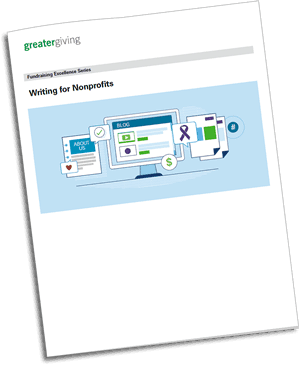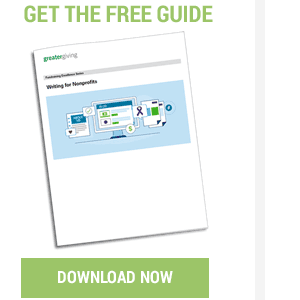

This post is the fourth in a series designed to teach the art and fundamentals of writing for nonprofits. These posts are based on the “Writing for Nonprofits” Guide from the Greater Giving Fundraising Excellence Series. Each new post focuses on an individual type of communication or relationship, and how best to tailor your writing to it. Read additional articles: Writing For Nonprofits Series
I thought about breaking this up into multiple posts—one about how to thank donors, one on thanking volunteers, staff members, etc. But I remembered that this series is about writing, and voice, and in these ways I think that all thank you letters are one in the same.
With every thank you, whether you’re thanking someone for a monetary donation, or a donation of time and energy, you want to convey the same things: gratitude, sincerity, appreciation, and humility.
Your perfect thank you expresses sincere gratitude.
I know it sounds obvious, but true gratitude comes from the heart. It has a sound, a look, a feeling. Sincere gratitude comes from understanding why people have joined in supporting your mission, and appreciating the contribution each of them make toward accomplishing that mission.
We see a lot of phrases like this in donor thank you letters:
These sorts of form openings are bland; they obviously don’t radiate from the heart or from a place of genuine appreciation. It gives the sense that the writer felt obligated to send the note.
Anything that sounds like a form letter won’t give your donor or volunteer that valuable feeling of being individually appreciated. Instead, it comes across like they are another line item on your list.
True gratitude requires acknowledging exactly what this donor has contributed that meant so much to you; or what this volunteer has done that made such a difference. How much did your donor donate? What outstanding job did the volunteer do? And how has that contribution helped to achieve your mission?
Try an opening like this, instead:
The perfect thank you demonstrates why it all matters.
When people feel like they’ve made a difference—when they can see the tangible return of their donations and hard work—it inspires them to come back, to give again. So be specific in your thank you about how a contribution has helped achieve your mission or goal. If you can, tell a story about the impact it’s had!
 Who or what has this contribution helped? For example, perhaps this donation helped your organization purchase a new van to transport volunteers to work sites. Tell a story about the van, and how it was critical to your success. (And if you’re not sure how to write a compelling, shareable story, check out my other blog post about it!)
Who or what has this contribution helped? For example, perhaps this donation helped your organization purchase a new van to transport volunteers to work sites. Tell a story about the van, and how it was critical to your success. (And if you’re not sure how to write a compelling, shareable story, check out my other blog post about it!)The same goes for staff and volunteer thank you notes. How did a specific thing that this volunteer did help your mission? Perhaps a volunteer going above and beyond at your annual event helped you pull it off without a hitch.
Remember as you write your thank you letters that the feeling of giving money or time, and having a positive impact, is addictive. Show donors and volunteers the positive results of their work and contributions, and they’ll want to do even more. We all want to feel needed and valued.
The perfect thank you is prompt.
TIP
Consider adding some black-and-white photos you took on-site, or of your last project, so your donor can see the impact of their contribution.
That phrase, “Strike while the iron is hot,” isn’t too far off here. A prompt thank you letter will land with the greatest effect.
Get that thank you note in front of your donor, volunteer or staff person while it still has the power to resonate with them; while the event, donation, or goal is still fresh in their minds. To really come across as sincere and from the heart, a note of gratitude should come within a week of the donation or work event.
The perfect thank you is personalized.
Not every thank you letter can be written one at a time, but we can write it with care and heart. We can write it so it sounds personal, instead of like a form letter.
So avoid fancy wording that might make your letter sound distant or formal. Instead, your writing should be close up; talk directly to the person receiving it, and treat them like a valuable friend.
It’s gratifying to get a note like that—a note that feels genuine, personal, informal. It feels great to have your individual work appreciated. In a volunteer or staff thank you letter, for example, try to mention specific things that volunteer or staff person did that were above and beyond the call of duty. Tell a donor why they, specifically, are so critical to what you achieved.
The perfect thank you doesn’t always have to be prompted.
This is my favorite secret, so I saved it for last. Don’t just thank the people that matter most and work the hardest when you need to; thank them even when you don’t.
Appreciating our donors, staff, and volunteers is a year-round job! Have volunteer appreciation events. Thank them for their work. Remember your big donors on holidays and special events. Let them know you’re thinking about them, and how grateful you are for their support.


Great blog you have got here.. It’s hard to find good quality writing like
yours nowadays. I seriously appreciate individuals like you!
Take care!!
Thank you so much, glad to hear you enjoy. Don’t forget to subscribe to make sure you don’t miss any new articles!
Thanks!